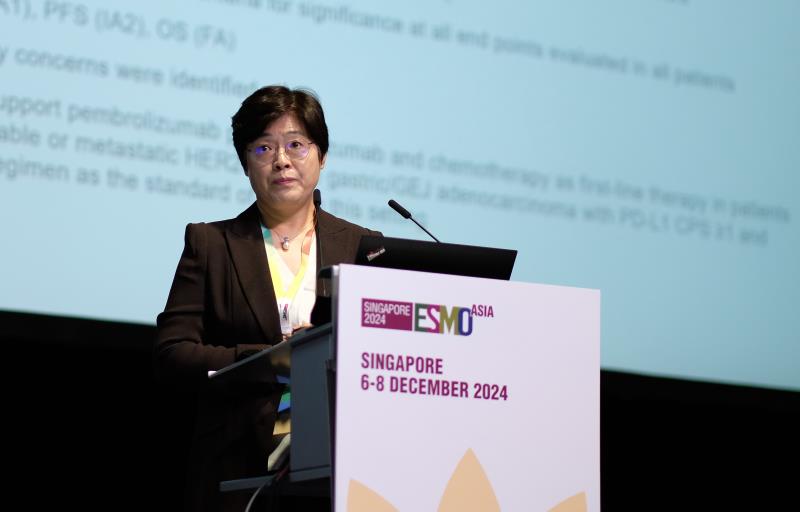KEYNOTE-811: Add-on pembrolizumab improves OS in HER2+ gastroesophageal cancer




 Prof Sun Young Rha
Prof Sun Young RhaAdding pembrolizumab to trastuzumab and chemotherapy significantly improves overall survival (OS) in patients with advanced unresectable or metastatic HER2+ gastric/gastroesophageal junction (G/GEJ) adenocarcinoma and in those with PD-L1 CPS ≥1, according to the protocol-specified final OS analysis of the KEYNOTE-811 trial presented at ESMO Asia 2024.
KEYNOTE-811 trial involved 698 patients with advanced unresectable or metastatic HER2+ G/GEJ, regardless of PD-L1 status, who were randomly assigned to receive pembrolizumab 200 mg IV Q3W (n=350, mean age 62 years) or placebo IV Q3W (n=348, mean age 63 years) in addition to trastuzumab and chemotherapy (FP* or CAPOX**).
At a median follow-up of 50.2 months, patients treated with pembrolizumab + trastuzumab and chemotherapy had a significantly longer median OS (20 vs 16.8 months; hazard ratio [HR], 0.80; p=0.0040) than those treated with placebo + trastuzumab and chemotherapy. [ESMO Asia 2024, abstract 128MO]
Moreover, the 36-month OS rate was higher among patients on the pembrolizumab regimen than those on trastuzumab and chemotherapy only (28 percent vs 23 percent).
The median progression-free survival (PFS) was prolonged in the pembrolizumab vs the placebo group (10 vs 8.1 months; HR, 0.73), which was consistent with the previous analysis.
Objective response rate (ORR) was higher with the pembrolizumab regimen compared with trastuzumab and chemotherapy only (72.6 percent vs 60.1 percent), as were complete (17 percent vs 11.8 percent) and partial responses (55.4 percent vs 48.3 percent).
PD-L1 subgroup
Similar benefits were seen in patients with PD-L1 CPS ≥1, in which the combination of pembrolizumab + trastuzumab and chemotherapy led to longer median OS (20.1 vs 15.7 months; HR, 0.79) and PFS (10.9 vs 7.3 months; HR, 0.72) compared with trastuzumab and chemotherapy only. However, those with PD-L1 CPS <1 did not show significant differences in OS and PFS between the treatment groups.
A higher ORR was observed among patients with PD-L1 CPS ≥1 in the pembrolizumab arm vs the placebo arm (73.2 percent vs 58.4 percent), with a median duration of response of 11.3 months vs 9.5 months, respectively.
Safety
In terms of safety, the rates of treatment-related adverse events (AEs) were similar between the pembrolizumab and placebo arms (97 percent for both).
Although the addition of pembrolizumab slightly increased the frequency of immune-mediated AEs and infusion reactions, all were considered grade 1/2 in severity, with no new safety concerns identified, noted Prof Sun Young Rha from Yonsei Cancer Center at Yonsei University College of Medicine in Seoul, Korea.
First-line standard of care
“At final analysis, first-line pembrolizumab + trastuzumab and chemotherapy … provided a statistically significant and clinically meaningful improvement in OS in all patients with unresectable or metastatic HER2-positive G/GEJ adenocarcinoma,” said Rha.
“Overall, KEYNOTE-811 met prespecified criteria for significance at all endpoints, [including ORR, PFS, and OS], evaluated in all patients,” Rha noted. “These data support pembrolizumab + trastuzumab and chemotherapy as first-line therapy in [this patient population] … and confirm this regimen as the standard of care in this setting.”